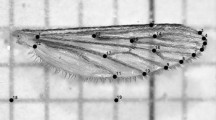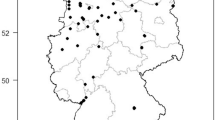Abstract
Diversity amongst the different populations is one of the problems in the control of medically important mosquitoes. Wing morphometry was used to identify within-species variation amongst some populations of Aedes aegypti in three areas of Lagos State, Nigeria. Ten landmarks on the right wing of adult female Ae. aegypti mosquitoes were digitized using TPSdig software. Relative distances of the veins and interpoints were calculated as well as the Euclidean distances based on these relative distances. In three (50%) of the interpoints, the relative distances were significant (P < 0.05) to both the Brown- Forsythe F ratio and Welch ANOVA. The highest Euclidean distance of 7.738 was between Ebute Metta 2 and Badagry; the lowest of 4.426 was between Ikorodu and Ebute Metta 2. The distance between Ebute Metta 1 and Ebute Metta 2 was 5.867, which is more than the distance between Ebute Metta 2 and Ikorodu. Three groups of Ae. aegypti were identifed, and the differences in lengths and interpoints observed on the wing veins suggest a possible morphological divergence amongst populations.
Similar content being viewed by others
References
Bosio C. F., Harrington L. C., Jones J. W. and Scott T. W. (2005) Genetic structUre of Aedes aegypti populations in Thailand using mitochondrial DNA. The American Journal of Tropical Medicine and Hygiene 72, 434–442.
Brown J. E., McBride C. S., Johnson P., Ritchie S., Paupy C., Bossin H., Lutomiah J., Fernandez-Salas I., Ponlawat A., Cornel A. J., Black 4th W. C., Gorrochotegui-Escalante N., Urdaneta-Marquez L., Sylla M., Slotman M., Murray K. O., Walker C. and Powell J. R. (2011) Worldwide patterns of genetic differentiation imply multiple ‘domestications’ of Aedes aegypti, a major vector of human diseases. Proceedings of the Royal Society B: Biological Sciences 278, 2446–2454. doi:10.1098/rspb.2010.2469.
Chhilar J. S. (2014) Morphometric analysis of taxonomic characters of malaria vector mosquito Anopheles (Cellia) subpictus Grassi (Diptera: Culicidae). Journal of Entomology and Zoology Studies 2, 32–38.
Craig G.B., Vandehey Jr R. C. and Hickey W. A. (1961) Genetic variability in populations of Aedes aegypti. Bulletin of the World Health Organization 24, 527–539.
Demirci G., Lee Y., Lanzaro G. C. and Alten B. (2012) Alti-tudinal genetic and morphometric variation among populations of Culex theileri Theobald (Diptera: Culicidae) from northeastern Turkey. Journal of Vector Ecology 37, 197–209.
Dhivya R. and Manimegalai K. (2013) Wing shape analysis of the Japanese encephalitis vector Culex gelidus (Diptera: Culicidae) at the foothills of southern Western Ghats, India. World Journal of Zoology 8, 119–125.
Dujardin J. P., Le Pont F. and Baylac M. (2003) Geographical versus interspecific differentiation of sand flies (Diptera: Psychodidae): a landmark data analysis. Bulletin of Entomological Research 93, 87–90.
Dujardin J. P. (2011) 16 - Modern morphometrics of medically important insects, pp. 473–501. In Genetics and Evolution of Infectious Disease (edited by M. Tibayrenc). Elsevier, London. ISBN 9780123848901, http://dx.doi.org/10.1016/B978-0-12-384890-1.00016-9. (https://doi.org/www.sciencedirect.com/science/ article/pii/B9780123848901000169)
Francoy T. M., Grassi M. L., Imperatriz-Fonseca V. L., de Jesús May-Itzá W. and Quezada-Euán J. G. (2011) Geometric morphometrics of the wing as a tool for assigning genetic lineages and geographic origin to Melipona beecheii (Hymenoptera: Meliponini). Apidolo-gie 42, 499–507. doi:10.1007/s13592-011-0013-0.
Gafur A. and Ajizah A. (2008) The use of female wing measurements for discrimination of Aedes aegypti (L.) (Diptera: Culicidae) populations from South Kalimantan. HAYATI Journal of Biosciences 15, 8–12.
Gillies M. T. and Coetzee M. (1987) A Supplement to the Anophelinae of Africa South of the Sahara (Afrotropical Region). The South African Institute for Medical Research, Johannesburg. Volume 55, 143 pp. Available at: https://doi.org/mosquitocatalog.org/fles/pdfs/190531.pdf
Henry A., Thongsripong P., Fonseca-Gonzalez I., Jaramillo-Ocampo N. and Dujardin J. (2010) Wing shape of dengue vectors from around the world. Infection, Genetics and Evolution 10, 207–214. doi:10.1016/j.meegid.2009.12.001.
Jaramillo O. N., Fonseca-González I. and Chaverra-Rodríguez D. (2014) Geometric morphometrics of nine field isolates of Aedes aegypti with different resistance levels to lambda-cyhalothrin and relative fitness of one artificially selected for resistance. PLoS ONE 9(5), e96379. doi:10.1371/journal.pone.0096379.
Lagos State Ministry of Health (2012). Malaria Control Programme. (https://doi.org/www.lagosstateministryofhealth.com/programmes/ malaria-control-program#.V3Ud0JN95Bx). accessed 30 June, 2014.
Mondal R., Devi N. P. and Jauhari R. K. (2015) Landmark-based geometric morphometric analysis of wing shape among certain species of Aedes mosquitoes in District Dehradun (Uttarakhand), India. Journal of Vector Borne Diseases 52, 122–128.
Mooi E. and Sarstedt M. (2011) A Concise Guide to Market Research: The Process, Data and Method Using IBM SPSS Statistics. Springer-Verlag, Berlin. 308 pp.
Nasidi A., Monath T., DeCock K., Tomori O., Cordellier R., Olaleye O. D., Harry T. O., Adeniyi J. A., Sorungbe A. O., Ajose-Coker A. O., van Der Laan G. and Oyediran A. B. O. (1989) Urban yellow fever epidemic in western Nigeria, 1987. Transactions of the Royal Society of Tropical Medicine and Hygiene 83, 401–406.
O’Malley C. (1995) Seven ways to a successful dipping career. Wing Beats 6(4), 23–24.
Paupy C., Chantha N., Huber K., Lecoz N., Reynes J. M., Rodhain F. and Failloux A. B. (2004) Influence of breeding sites features on genetic differentiation of Aedes aegypti populations analyzed on a local scale in Phnom Penh municipality of Cambodia. American Journal of Tropical Medicine and Hygiene 71, 73–81.
Rohlf F. J. (1990) Morphometrics. Annual Review of Ecology and Systematics 12, 299–316. doi:10.1146/annurev.es.21.110190.001503.
Rueda L. M. (2004) Pictorial Keys for the Identification of Mosquitoes (Diptera: Culicidae) Associated with Dengue Virus Transmission, 1st edn. Magnolia Press, New Zealand. 60 pp.
Sendaydiego J. P., Gorospe J. M., Torres M. A. J., Amparado Jr R. F. and Demayo C. G. (2014) Describing wing shape among Culex quinquefasciatus Say (Diptera: Culicidae) detected positive and negative for flaria using relative warp analysis. Journal of Medicine and Bioengineering 3, 50–54.
Sendaydiego J. P., Torres M. A. and Demayo C. G. (2013) Describing wing geometry of Aedes aegypti using landmark-based geometric morphometrics. International Journal of Bioscience, Biochemistry and Bioinform-atics 3, 379–383.
Severson D. W., Anthony N. M., Andreev O. and ffrench-Constant R. H. (1997) Molecular mapping of insecticide genes in the yellow fever mosquito (Aedes aegypti). Journal of Heredity 88, 520–524.
Sokal R. R. and Rohlf F. J. (1995) Biometry. 3rd edition. W.H. Freeman and Company, New York. 887 pp.
Tabachnick W., Munstermann L. and Powell J. (1979) Genetic distinctness of sympatric forms of Aedes aegypti in East Africa. Evolution (N.Y.) 33, 287–295.
Vidal P., Carvalho E. and Suesdek L. (2012) Temporal variation of wing geometry in Aedes albopictus. Memórias do Instituto Oswaldo Cruz, Rio de Janeiro 107, 1030–1034.
Wikipedia (2015) Comstock-Needham System. (https://doi.org/en.wikipedia.org/wiki/Comstock%E2% 80%93Needham_system)
Author information
Authors and Affiliations
Corresponding author
Rights and permissions
About this article
Cite this article
Ayorinde, A.F., Oboh, B.O. & Otubanjo, O.A. Differentiation of some populations of Aedes aegypti (Diptera: Culicidae) in three areas of Lagos State, Nigeria, using wing morphometry. Int J Trop Insect Sci 36, 171–176 (2016). https://doi.org/10.1017/S1742758416000151
Accepted:
Published:
Issue Date:
DOI: https://doi.org/10.1017/S1742758416000151




